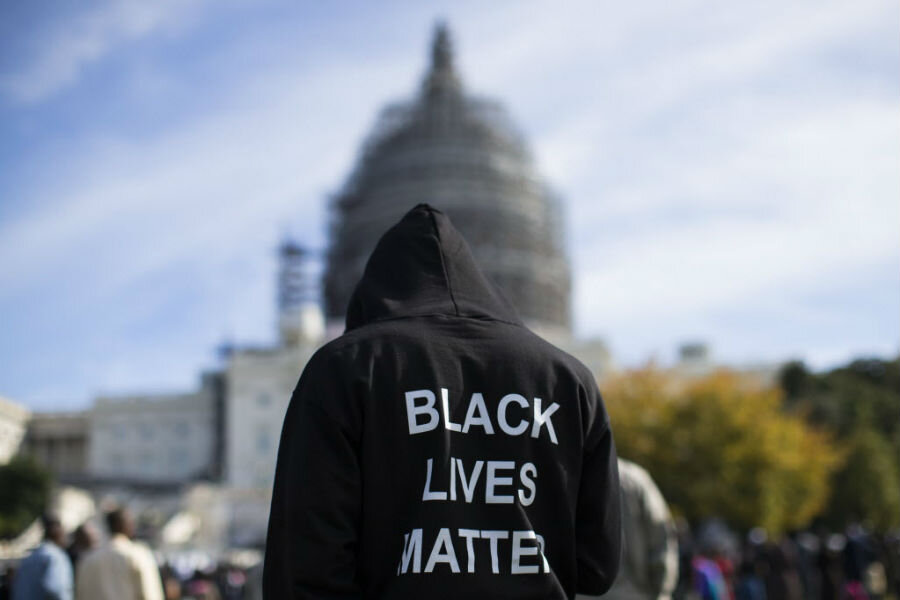What does 'black-on-black crime' actually mean?
Loading...
In an Ohio church meeting, Republican presidential nominee Donald Trump was asked by an audience what he would do about “violence in the black community.”
“I wanted to know, what would you do to help stop that violence, black-on-black crime,” the unidentified male said, according to a transcript of the meeting.
To much subsequent criticism, Mr. Trump went on to suggest using stop-and-frisk, a strategy ruled unconstitutional for its disproportionate targeting of minorities. But less attention was paid to the question itself and the idea of “black-on-black crime” that insinuates the outsized role race plays in contributing to violence in the black community.
The term is most often heard these days after police shootings of black individuals to counter protests from the Black Lives Matter movement by those who believe that the black community should solve its own problems – specifically, high rates of homicides – before protesting about police brutality.
“Let’s not pretend that our morgues and cemeteries are full of young black men because cops are shooting them,” said Wall Street Journal editorial board writer Jason Riley on NBC's "Meet the Press" after the Michael Brown shooting in 2014. “The reality is that it’s because other black people are shooting them. And we need to talk about black criminality.”
Violence in black communities is borne out by statistics: The numbers from the Bureau of Justice Statistics show that from 1980 to 2008, blacks were six times more likely than whites to be homicide victims and seven times more likely than whites to commit homicide. But the problem with perpetuating the phrase “black-on-black crime,” many activists and scholars argue, is that it traces the cause of violence to race – instead of examining other factors such as poverty and lack of job opportunities.
“Every time the term black-on-black crime is used, the term that comes to human consciousness is race,” David Wilson, professor at the University of Illinois and author of "Inventing Black-on-Black Violence," told The Christian Science Monitor in a phone interview. “The term really privileges that notion that race is at the core of the process.”
It is most misused when implying that intraracial violence is unique to the black community, as former New York Mayor Rudy Guiliani did, pointing out that “93 percent of blacks are killed by other blacks.”
Federal data has shown that it’s the same for white-on-white crime: Between 1980 and 2008, 84 percent of white victims were killed by whites, and the differences remained slim throughout 2009 to 2013.
Those statistics may be reflective of other factors, such as poverty rates, disparities in opportunity, and segregation of neighborhoods, rather than any indication that black communities inherently struggle with internal strife more white communities, advocates say.
The term black-on-black crime "invokes that there is something different about the racial category of blacks,” Dr. Wilson says. “Naming a process says so much about how you choose to understand the process. It’s really saying that Black Lives Matter is not that important because these are just black people making bad choices.”
Wilson culled through more than 20 years of news articles to find out where the term “black-on-black crime” first appeared in everyday lexicon. He found that in the 1970s and '80s, it was used to describe crime in Chicago and other cities where the perpetrator and victim of homicides were black.
But the term is not a description used only by whites. Former Baltimore Ravens linebacker Ray Lewis said in a Facebook video in April that “everyday we have black-on-black crime killing each other,” criticizing the Black Lives Matter movement for ignoring the problem.
The NAACP also talked about black-on-black crime and how it must be addressed.
“How do we give life to the narrative that Black Lives Matter when we are doing the killing?” said chairman Roslyn Brocks in the 2015 annual convention. “Let me be crystal clear black-on-black crime must end in our community as we imbue new life and meaning into the often quoted hashtag #Black Lives Matter!”
The Black Lives Matter movement addressed the criticism on their website by stating that they do care about black-on-black crime and the initiatives taken to reduce violence. But they also point out that it is a diversion.
“The continued focus on black-on-black crime is a diversionary tactic, whose goal is to suggest that black people don’t have the right to be outraged about police violence in vulnerable black communities, because those communities have a crime problem,” it reads.
In a May 2015 study coauthored by Rod Brunson, dean of the Rutger’s School of Criminal Justice, and Anthony Braga, director of Northeastern University School of Criminology and Criminal Justice, argues that use of the term “black-on-black crime” brings negative consequences and can be problematic when used by political commentators, politicians, and police.
“We don’t argue that it is not statistically accurate that most crimes are intraracial,” Professor Brunson said in a phone interview with The Christian Science Monitor. “[But] it is used in such a way to suggest that black people are the more morally deficient member [of the society.]”
The term itself, he says, is not problematic. It’s the context in which it is used.
“It really depends on the context in which you use it,” Brunson says. “If police leaders are standing before a community on the heels of a tragic event like a homicide or shooting and they use the term, it could suggest that the community endorses or accepts the violence.”
Brunson emphasizes that the black community has been taking steps to resolve it, citing the Boston Ten Point Coalition as an example.
"Concentrated poverty, poor schools, poor social service, all these create conditions where crime is disproportionately observed in a minority community," he says. "Crime isn’t particularly unique to a racial group."








